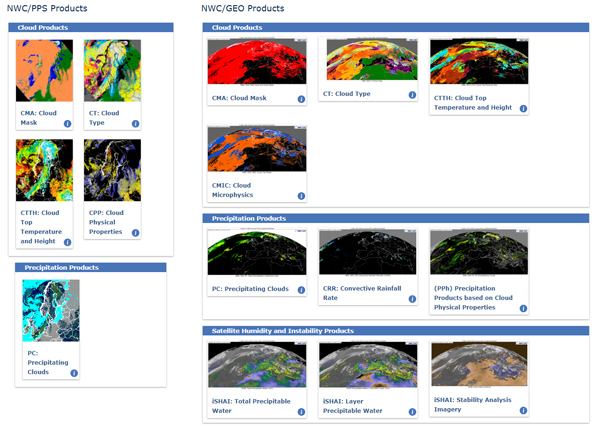Agencia Estatal de Meteorología
- Weather
- Climate services
- Know us
- R&D+I
- Knowing more
- Public employment and scholarships
- Open data
- Virtual office
EUMETSAT's Nowcasting SAF (NWC SAF), leaded by AEMET, is included in the Satellite Application Facilities Network that the European Organisation for the Exploitation of Meteorological Satellites (EUMETSAT) has all over Europe as part of its Ground Segment.
The main objective of Nowcasting SAF is providing products and the corresponding operating services to optimize the use of satellite data for Nowcasting and Very Short Range Forecasting. At present the software of NWCSAF is applicable to the meteorological satellites MSG (Meteosat Second Generation). In the version 2018 it incorporates support for the geostationary satellite HIMAWARI. The Nowcasting SAF software is equally applicable to the polar satellites PPS (Shots-NOAA, EPS-Metop, Suomi-NPP) and in its version 2018 will progressively expand its support for low-orbiting satellites: JPSS, FY-3D, FY -3E.
The final aim is the distribution of Software Packages to the International Meteorological Community, so that the user can generate the Products at their premises. NWC SAF is responsible for the developing and maintenance of the Products and Software Packages, as well as for the scientific, technical and training support to users.
Information about the requisites for getting the software, as well as images of the products in near real time and scientific documentation is available at: NWCSAF WEB
Former INM was tasked with the development of Nowcasting SAF in 1997, leading a consortium of Meteorological Services that included, apart from the Spanish one, France (Météo-France), Sweden (SMHI) and Austria (ZAMG) Meteorological Services -Romania (NMA) joins the consortium in 2017-.
From the beginning, NWC SAF has been developing through different phases that are explained below:

Nowcasting SAF tasks can be divided into four categories in AEMET:
By June 2018, there are 128 authorised users, mostly from European, Asian and American Meteorological Services, Universities and Research Centres. The authorization is made online from the web page.
NWC SAF is an International Project, so that all the work, documentation, meetings, communication with users, etc? Is held in English. So, all the NWCSAF staff must have a very high English level.
NWC SAF product developers, both in AEMET and the Consortium Meteorological Services, are highly qualified, and must be aware of the state of the art knowledge and development of their specific responsibility area, and must definitely have a very high level in Atmospheric Physics, Meteorology and Software Developing for Data and Image Processing, among others.
The AEMET team consists of a Project Director, a Chief of Operations, a Chief of Science and Engineering and four Developers, with the support of the general staff of AEMET and support in private sector engineering.
NWCSAF Project is completely structured into actions that have to be done within the closing date agreed, being reviewed in the different Project Team and Steering Group Meetings, where its fulfilment is required. Products and System Components are thoroughly verified and validated, being liable to timely reviews by external reviewers.